Arms may look like a Mario Party mini-game, but it doesn’t play like one. Charming and involved, Arms toes the line between a party game and an entry-level fighter with moderate depth. While Arms succeeds as an easy-to-pick-up brawler, its ambitions as a hardcore game for serious players are less certain.
Arms does one thing, and it does it well: you can punch people with long, slinky limbs. In Arms, you choose one of ten fighters with 30 interchangeable fists between them. Rockets, laser-beaming dragons, zapping wrecking balls and whip-slapping paddles all inflict different effects on opponents, like blindness, shock or big, big damage.
After picking a fighter and two arms, you and an opponent battle it out on any of Arms‘ 3D stages, like a hoverboard skate park, or a great, big bowl of ramen. Arms wouldn’t be a Nintendo game without random items, and sure enough, stages spawn healing energy drinks, power serums and exploding volleyballs. Players dodge each other’s blows while guarding or charging up their arms for special attacks. It’s like a weird, absurdist Rock ’em Sock ’em Robots.
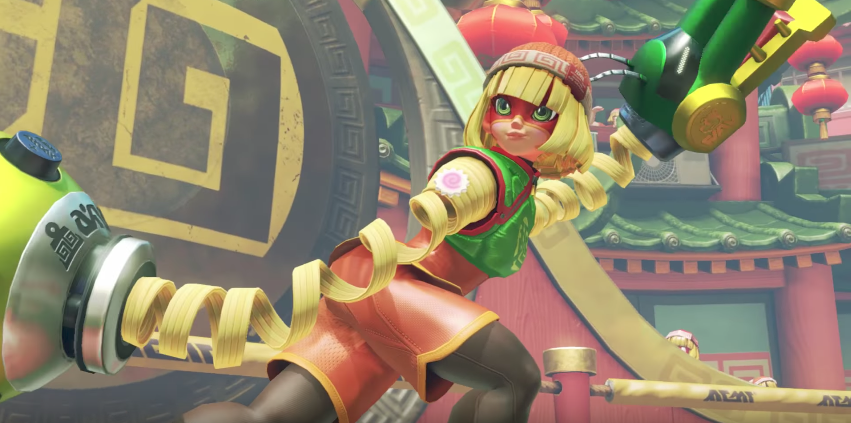
Arms
That absurdism filters down to the characters, making Arms’ fighters easy to love. Twintelle’s classy mystique and Helix’s globule, jelly consistency already provoked strong reactions weeks prior to Arms’ release.
“The ramen bomber” Min Min, with her beanie an upside-down ramen bowl and stringy, ramen arms, is ridiculous and amazing. Spring Man’s cotton candy swirl of hair reminds me of a twisted Nintendo Superman. Kid Cobra looks like he fell into a “Sale” bucket at a ’90s mall skate shop, and then got bit by a radioactive snake.
What’s the story, here? Well, a few days ago, Glixel asked Arms producer Kosuke Yabuki about the game’s lore. He responded, “If you really want to know why they have stretchy arms? The real answer is: because Nintendo.”
Yabuki wasn’t far off — a Nintendo Direct video and a small, Japanese social media campaign have hinted at a story. It’s literally: one day, people just woke up with extendable spring arms. Nobody knows why. Some of those folks decided to use their arms to make money fighting. Nintendo has said they will add more lore later.
Fighters’ stories are a bit more fleshed-out. In its single-player mode, short sequences narrated by a squeaky little guy named Biff string together fights with little factoids about Arms characters: We know that Mechanica, a girl with a yellow mech suit, constructed her robot exterior at her father’s scrapyard, and that Helix had a childhood crush on Twintelle. Of the hulking, mummified fighter Master Mummy, Biff says, “You may be wondering why a manic, howling monster would want to win this kind of tournament. Well, so am I.”
In truth, the inhabitants of Arms‘ world have little in common except spring arms, something Biff seems to embrace with his scatterbrained commentary. Minimal lore works in Arms‘ favour, though — without a body of literature to consume, it’s easier for new players to dive in. And, anyway, it is a fighting game.
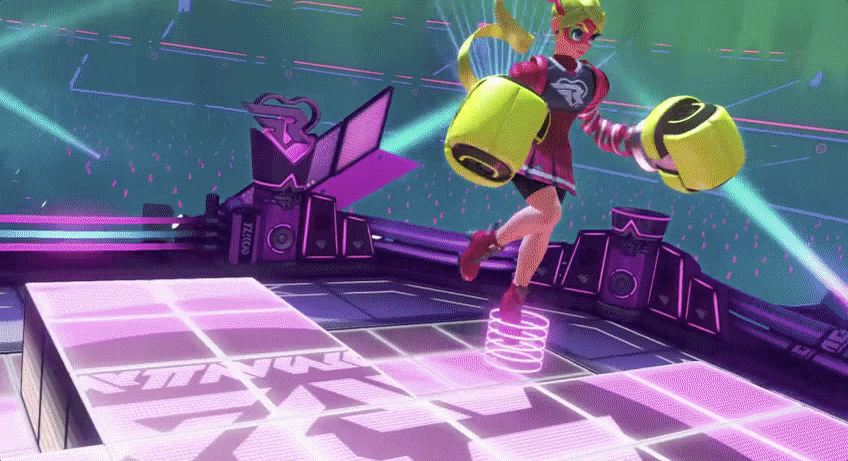
Arms
Fighting in Arms is easier to grok than it is to master. In theory, it’s not much more complicated than rock, paper, scissors. Players can punch, grab and guard. Punching breaks grabs, grabs break guards and guards, well, guard from punches. Those are the basics. There are also “Rush” attacks, or high-powered, short-duration moves that build up over time, as well as each arms’ special attacks that charge when a player guards for a little longer than normal. It’s simple in theory, but in practice, it can feel a little overwhelming.
How slowly or quickly does each chosen arm move? Is my right arm heavy enough to punch through an enemy’s blow? Is your left arm so slow that your opponent hit you faster than you could hit them? OK — my zapping arm disabled them, so should I risk a grab? These are a few of the questions you’ll ask yourself, at lightning speed, mid-match. Strategy figures in, too — arms each have their own weight (light, medium and heavy) and element, and move combinations add levels of thoughtfulness beyond healthy impulses. I found myself mentally reciting small facts about arms’ powers and weights and vulnerabilities prior to matches. It’s full of mini, rapidfire logic puzzles — as any fighting game is — but because Arms is so streamlined, the skeleton of its mechanics is more immediately visible.
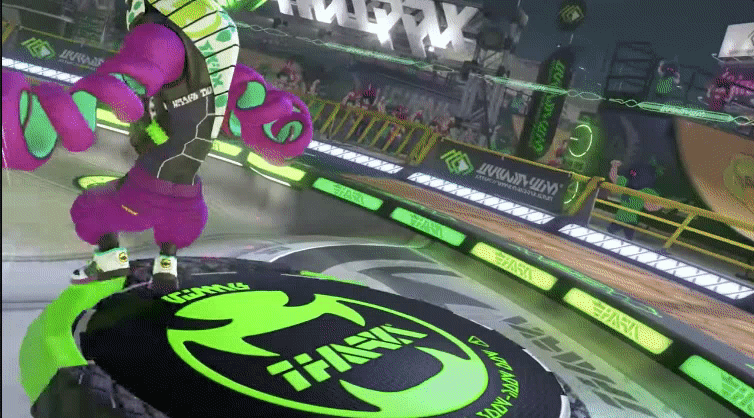
Arms
When played right, Arms is deeply psychological. Mastering it — and I certainly have not — requires monk-like patience, good judgement and dexterity. Playing well is all about exploiting opponents’ impulsive decisions. It’s not a juggling contest like Tekken or a test of spatial reasoning like Super Smash Bros. It’s about knowing that your heavy left arm will hit your opponent through their grab, or that your opponent’s brutal, slow “Megaton” won’t land if you jab them with a faster arm first. With small technical factors — like arms’ curvature or height difference — aside, Arms is primarily about immediately thinking of and enacting the perfect counter to your opponent’s move.
Beyond classic 1 vs. 1 matches, Arms also includes a few take-or-leave mini-modes such as volleyball, basketball, team fight, target practice and 1-on-100. These side games are essentially palate cleansers between 1 vs. 1 matches. In “V-Ball,” you and an opponent rush to hit, spike and save an exploding volleyball. In “Hoops,” you dunk your opponent by grabbing them.
“Skillshot” is a weird combination of target practice and hitting an opponent from the other end of a court. 1-on-100 pits you against a horde of easy-to-kill enemies. And finally, “Team Fight,” in my opinion the game’s worst mode, inexorably attaches two players with a rope in a two vs. two game. I find Team Fight nearly unplayable because of how little control I have over my fighter’s movement and camera view. When my teammate is thrown, my view is jerked around and, for a full two or three seconds, I’m completely disoriented. I do not play these modes unless I’m mining coins to unlock more arms, multi-tasking or commuting.
There’s also a single-player mode called “Grand Prix,” (also playable in co-op), that runs players through ten fights spanning across all those modes. The rhythm is nice, but playing against other humans brings more variation, in my opinion — especially since there isn’t much of a story going on. After a half dozen playthroughs, I found the “Grand Prix” hopelessly repetitive (yet relaxing while watching television.)
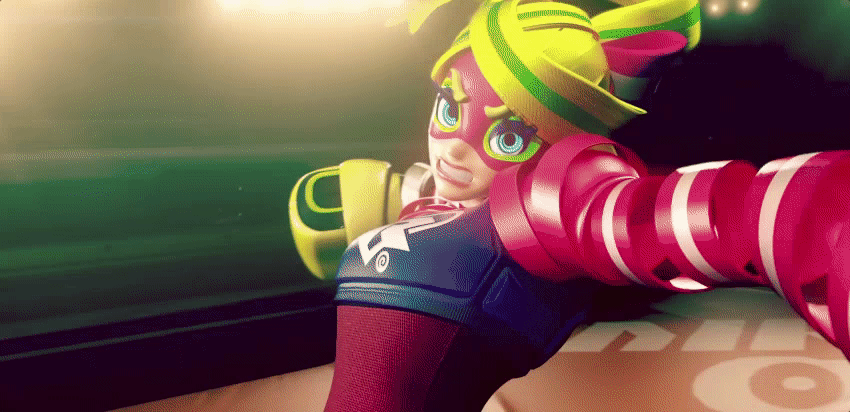
Arms
Wisely, Nintendo split Arms’ online modes into “Party Match” and “Ranked Match,” and both match-make accurately and with impressive speed. “Party” thrusts the player into any one of its modes, randomly, plus a three-person battle royale mode that feels a lot like you and another player sealing a third’s lunch money. “Ranked” is a 1 vs. 1 mode that, in the tradition of Super Smash Bros., is a clean contest of skill. No items, randomised stage. At first, winning amasses huge exp. gains. And unless you are irredeemably bad, you probably won’t lose levels, cutely named things like “Snail” and “Pinwheel.” Arms does “Ranked” well, and because it isn’t punishing, it’s always fun to play.
That said, making “fun” its main attraction is risky. Opponents have left or disconnected in half of the ranked matches I’ve dominated.
Arms strives to balance accessibility and seriousness, with mixed results. In my experience, Arms succeeds in its grab for unseasoned gamers or folks who don’t play competitive games. I’ve roped buddies into Arms matches while waiting for a third friend to put on mascara, and in innumerable other situations along these lines. I’ve forced acquaintances (or strangers) who have played no games into impromptu Arms matches, and in seconds, they’re punching and blocking with some competence — and enjoying it. Arms‘ multiplayer is a great success for the Switch’s portable kickstand mode.
Contributing to that accessibility, learning how to play Arms is straightforward. The game’s “Help” section perfunctorily describes a few facts about each fighter, special powers and go-to strategy, though not in a very detailed or organised fashion. Also, its “Training” modes, which cycle players through a crash course in throwing, blocking and countering punches, as well as helpful strats like “Don’t get thrown” and “Anti-jump practice,” are very, very thorough. There’s no mystery in this game, because there doesn’t have to be.
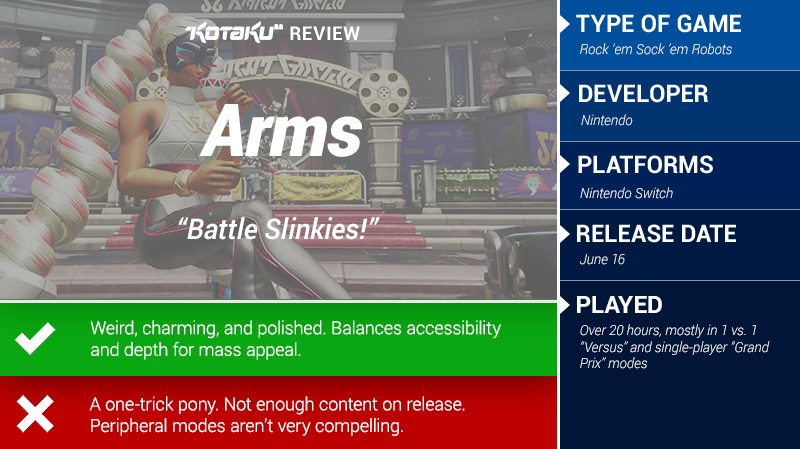
Arms‘ attempt at accessibility seems at odds with Nintendo’s insistence on the game’s competitive potential.
Strangely, and paradoxically, both early advertising and Arms producer Yabuki have said that Arms‘ competitive potential lies in its motion control capabilities, where players punch forward with a Joy-Con in each hand. Yes, punching with Arms’ motion controls is a fun novelty that people who never play games can immediately understand, though the idea that punching movements will translate to serious competitive play feels laughably out of touch. I play almost exclusively in handheld mode because it closes the distance between my manual inputs and what I see on the Switch’s screen.
Serious players may have a few gripes with Arms’ mechanics: I was frustrated by arms’ significant auto-aiming. I found that, often, when a fighter stood up from a fall, a crazy number of poorly-communicated invincibility frames follow. Sometimes, punches and grabs move through an opponent when they should hit. On top of that, players have no control over the camera, which basically determines their line-of-sight. As a 3D game, that limits how creative players can be with their grabs and dodges. I always feel like I’m pushing against an invisible wall when moving around a stage. These are small gripes, but significant ones for players banking on some level of mastery.
Also counting against its competitive ambitions is its small roster and poor combo infrastructure — something competitive gamers really look for. Instead of dozens of fighters, Arms has eleven. A great combo in Arms means two or three attacks together, or probably some chain grabs, which feel plain and cheap.
It feels a little unfair to those competitive ambitions because they’re so obviously an instrument of advertising and not a true call for an esports infrastructure. Nintendo’s track record for propping up its esports infrastructures isn’t great, which makes me sceptical that Arms will walk the walk. At the very least, we know that Arms will receive a multitude of free updates post-release, which will help keep it alive for some time.
The biggest problem with Arms right now is that it lacks content. Sure, more lore, fighters, stages and arms will come via free DLC, but it only took me about ten hours to see most of what the game had to offer.
Arms is a one-trick pony. That one trick is polished and addictive, with deep minutia worth mastering. What makes it so eminently replayable is each battle’s constant and fluid power struggle; the ah-ha of dodging an opponent’s grab, jumping up and grabbing them; moving that opponent into a vulnerable corner with a boomerang arm; or the exhilaration of landing a slow, large “Megaton” punch.
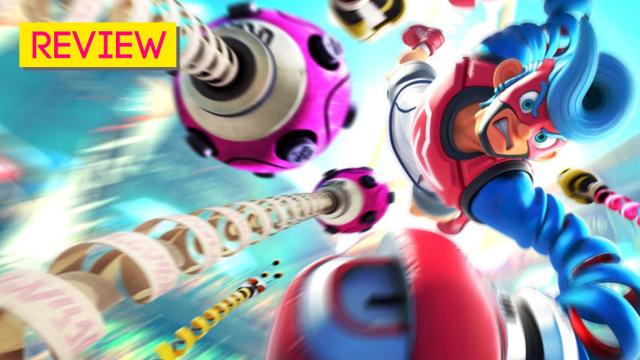
Comments
2 responses to “Arms: The Kotaku Review”
This whole paragraph is the majority of what gets me most angry when playing this game. Just cannot comprehend the damn thing, “why does nothing work??”
Eh, personally I prefer a smaller roster. Eg Smash with its fifty-something odd roster is way too fucking huge, I have no idea what’s going on any more and can’t remember people’s moves half the time. A dozen’s totally fine.
I “bought”/borrowed this game from EBgames. I played through the Single Player mode twice and got bored during the first run. I’m sure it’s slightly more fun in mulitplayer, and it’s an okay idea, but even factoring that in, it didn’t seem worth it to me. Might be good for younger kids perhaps, but it kind of seems like something that should just be on a ‘Wii Sports’ type thing, that way there’s variety with other things, and you can come back to it in short bursts amongst other games. It ended up being about what I expected though…
I’ll be selling my copy on eBay for $40. Valiant attempt at new IP from Nintendo, seemingly full of fun and polish with nicely-handled online matches. But my experience in online party mode was an exercise in knowing I would win immediately, or knowing that I had no hope of winning, immediately. Very little middle ground – and so, very little enjoyment in the fights. Attempting to go to ranked, where I might be matched against similar (not very good) opponents, found me unable to beat the AI in a grand prix on level 3. I could trounce the AI opponent in a given round, only to find myself barely able to score a hit on the same opponent, same skill level, in the following round. There appears to be no rhyme or reason to a winning strategy; if ranked is full of people that can beat this skill level – then no thanks. No Nintendo game has made me want to throw the controllers through the window like this one. Good work, Nintendo – and I really do mean that – but if you’re going to market a game as accessible, make it more accessible. If it’s more hardcore – then the aesthetics or marketing (and the reviews) should reflect that. I know I don’t want to play Dark Souls, because everything about the game and the reviews is telling me it’s really difficult. But Nintendo, and the reviews, convinced me this game was fun. Granted, it ATTEMPTS to be fun. But it’s turned out to be the opposite. It’s lost me as a player, and it needs some serious balance tweaks if it were to lure me back again.
I’ll make some money back and spend it on Splatoon 2. Both the single player and online experience of #1 are extremely enjoyable for me, hopefully #2 continues this.